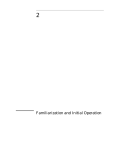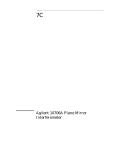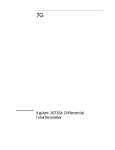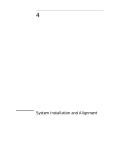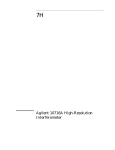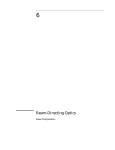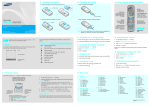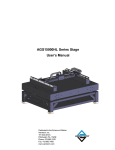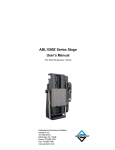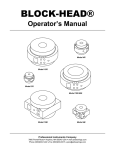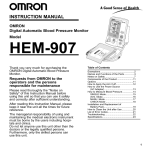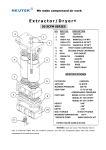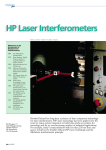Download Agilent 10705A Single Beam Interferometer and Agilent 10704A
Transcript
7B Agilent 10705A Single Beam Interferometer and Agilent 10704A Retroreflector Chapter 7B Agilent 10705A Single Beam Interferometer and Agilent 10704A Retroreflector Description Description The Agilent 10705A Single Beam Interferometer (shown in Figure 7B-1) is intended for use in low-mass or limited-space applications. This Interferometer is designed for use with the Agilent 10704A Retroreflector (shown in Figure 7B-1); a special option (C01-10705A, described later in this subchapter) provides an Agilent 10705A interferometer that can be used with plane mirrors or highly reflective surfaces. The single beam interferometer is called that because the outgoing and returning beams are superimposed on each other, giving the appearance of only one beam traveling between the interferometer and the retroreflector. Functionally, this interferometer operates like a linear interferometer, but is preferred when space for optics and beam paths is limited. M IN BEA TER F E 10 R T RE O EF R S/ L E CTO R R ETE M O R SINGLE The Agilent 10704A Retroreflector is a cube corner, but is considerably smaller and lighter than the Agilent 10703A Retroreflector. A N6 4A 70 70 5A Agilent 10705A Single Beam Interferometer 10 Agilent 10704A Retroreflector Figure 7B-1. Agilent 10705A Single Beam Interferometer and Agilent 10704A Retroreflector 7B-2 User’s Manual Chapter 7B Agilent 10705A Single Beam Interferometer and Agilent 10704A Retroreflector Description When using a single-beam interferometer, the receiver is usually mounted perpendicular to the measurement beam, and the interferometer held stationary. An optical schematic diagram of this interferometer is shown in Figure 7B-2. REFERENCE and MEASUREMENT PATHS (fA and fB ) Reference Cube-corner Agilent 10705A Single Beam Interferometer Quarter-wave Plates fB Agilent 10704A Retroreflector fA fA± ∆f fB fA From Laser Head fB fA ± ∆ f To Receiver LEGEND = fA = = fB = fA and fB Rounded corners are used to help you trace paths. Figure 7B-2. Single Beam Interferometer — laser beam path Laser beam path A polarizing beam-splitter reflects fB to the reference cube corner and transmits fA to the Agilent 10704A Retroreflector (Figure 7B-2). The return path is superimposes on the outgoing path. Since both beams leaving the beam-splitter pass through a quarter-wave plate, the returning polarizations are rotated through 90°. This causes fB to be transmitted and fA ±∆f to be reflected so that they are directed coaxially to the receiver along a path perpendicular to the input beam. Rotating the interferometer 90° switches which optical frequency is in the measurement path, and thus changes the direction sense. User’s Manual 7B-3 Chapter 7B Agilent 10705A Single Beam Interferometer and Agilent 10704A Retroreflector Description Differential measurements A differential measurement is one in which both the reference beam and the measurement beam travel to external reflectors outside the interferometer housing. This allows measurement of the relative positions of the two external mirrors, either or both of which may be moving. Viewed another way, this allows measuring the motion of one reflector relative to a reference datum elsewhere in the machine, external to the interferometer itself. This is unlike the typical interferometer configuration because usually the reference beam path length does not change; in differential configurations, it can. Take care during design and layout of a differential measurement to avoid introduction of alignment errors, thermal or mechanical instabilities, and potential deadpath problems. Both reflectors (reference and measurement) should be of the same type (cube corner or plane mirror); this minimizes thermal drift problems with ambient temperature changes. To use an Agilent 10705A Interferometer in a differential measurement configuration, the reference cube corner can simply be detached from the interferometer housing and attached to the reference surface of interest. This is shown, using an Agilent 10702A Interferometer for the example, in Figure 7A-7. Be aware that all installation and alignment requirements for the measurement reflector now apply also to the reference reflector. Plane mirror measurements The special option C01-10705A interferometer is an Agilent 10705A interferometer specially modified to allow its use with plane mirrors or highly reflective surfaces. The C01-10705A modification removes one quarter-wave plate, resulting in an optical configuration similar to that of the Agilent 10706A Plane Mirror Interferometer (described in subchapter 7C of this manual); this configuration requires one Agilent 10704A retroreflector. The C01-10705A interferometer’s receiver signal is separated by an Agilent 10700A or Agilent 10701A Beam Splitter. Typical measurement mirror alignment requirements for the C01-10705A (as a function of distance) are the same as those for the Agilent 10706A Plane Mirror Interferometer. Agilent 10706A interferometer specifications are given in subchapter 7C of this manual. 7B-4 User’s Manual Chapter 7B Agilent 10705A Single Beam Interferometer and Agilent 10704A Retroreflector Special Considerations Special Considerations Effect of optics on measurement direction sense The orientation and configuration of the interferometer affects the measurement direction sense. The direction sense depends on which frequency is in the measurement path of the interferometer. For example, if f1 (lower frequency) is in the measurement path and f2 (higher frequency) is in the reference path and the optics are moving away from each other, the fringe counts will be INCREASING. Interchanging f1 and f2 (perhaps by rotating the interferometer 90°, the measurement direction sense will change. This rotation causes switching of frequencies in the measurement path. Configuration effects The Agilent 10705A interferometer can be configured to turn the beam at right angles. Be aware that doing this will cause the measurement direction sense to be changed because the measurement reference paths are exchanged. Mounting Adjustable mounts Agilent 10710B Adjustable Mount provides a convenient means of mounting, aligning, and securely locking in position, the Agilent 10705A interferometer. Since the mount allows some tilt and yaw adjustment, the need for custom fixturing is minimized. This mount allows the optic mounted on it to be rotated about its optical centerline, simplifying installation. Chapter 4. “System Installation and Alignment” in this manual shows how to install an optic in various orientations, using an adjustable mount. Fasteners The Agilent 10706A interferometer is designed to be used with an Agilent 10710B Adjustable Mount, and is supplied with English mounting hardware User’s Manual 7B-5 Chapter 7B Agilent 10705A Single Beam Interferometer and Agilent 10704A Retroreflector Installation Installation Pre-installation checklist In addition to reading chapters 2 through 4, and Chapter 15, “Accuracy and Repeatability,” complete the following items before installing a laser positioning system into any application. Complete Beam Path Loss Calculation (see “Calculation of signal loss” in Chapter 3, “System Design Considerations,“ of this manual). Determine the direction sense for each axis, based on the orientation of the laser head, beam-directing optic, and interferometer. Enter the direction sense for each axis into the measurement system electronics. (See Chapter 5, “Laser Heads,” Chapter 14, “Principles of Operation,” and Chapter 15, “Accuracy and Repeatability,” in this manual. Provide for aligning the optics, laser head, and receiver(s) on the machine. (Ideally, you want to be able to translate beam in two directions and rotate beam in two directions for each interferometer input. This typically takes two adjustment optics with proper orientations.) Be sure to allow for transmitted beam offset of beam splitters (Agilent 10700A and Agilent 10701A) in your design. (See the offset specifications under the “Specifications” heading at the end of this subchapter.) Refer to Chapter 4, “System Installation and Alignment,” in this manual for installation instructions. 7B-6 User’s Manual Chapter 7B Agilent 10705A Single Beam Interferometer and Agilent 10704A Retroreflector Specifications and Characteristics Alignment Alignment aids Alignment aids for these interferometers are listed in Chapter 4, “System Installation and Alignment” and Chapter 9, “Accessories,” of this manual. Procedure Refer to Chapter 4, “System Installation and Alignment” in this manual for alignment instructions. Specifications and Characteristics Specifications describe the device’s warranted performance. Supplemental characteristics (indicated by TYPICAL or NOMINAL) are intended to provide non-warranted performance information useful in applying the device. The basic optical resolution using a linear interferometer is one half wavelength (0.316 micron, 12.26 microinches). Using electronic resolution extension, the system resolution is increased significantly. Depending on the system, an additional resolution extension factor of 32 (for Agilent 10885A and 10895A) or 256 (for Agilent 10897B and 10898A) is usually available. Interferometer Fundamental Optical Resolution System Resolution 1 (see NOTE) System Resolution 2 (see NOTE) Agilent 10705A λ /2 (316.5 nm, 12.5 µin) λ /64 (10.0 nm, 0.4 µin) λ /512 (1.2 nm, 0.047 µin) NOTE The system resolution 1 is based on using 32X electronic resolution extension. This is available with the Agilent 10885A and Agilent 10895A electronics. The system resolution 2 is based on using 256X electronic resolution extension. This is available with the Agilent 10897B and Agilent 10898A electronics. User’s Manual 7B-7 Chapter 7B Agilent 10705A Single Beam Interferometer and Agilent 10704A Retroreflector Specifications and Characteristics Agilent 10705A Single Beam Interferometer Specifications Dimensions: see figure below Weight: 85.5 grams (3.0 ounces) Materials Used: Housing: Stainless Steel (416) Apertures: Plastic (Nylon) Optics: Optical Grade Glass Adhesives: Low Volatility (Vacuum Grade) Maximum Transmitted Beam Deviation: ± 30 arc-minutes Optical Efficiency (including Agilent 10703A Reflector): Typical: 62% Worst Case: 59% Fundamental Optical Resolution: λ /2 Non-linearity Error: <4.2 nm (0.17 µin) #2-56 Screws (2) Centerline 15.2 mm (0.60 Dia) 6-32 UNC (4 Places) Thru Clearance For #4 or (2.5 mm ) 39.88 mm (1.57) SINGL E BE 25.65 mm (1.01) 8.9 mm Aperture (0.35 Dia) 25.65 5.65 mm (1.01) Centerline #2-56 4 Places 19.56 mm (0.77) Typ 19.56 mm (0.77) 19.56 mm (0.77) Figure 7B-3. Agilent 10705A Single Beam Interferometer — dimensions 7B-8 User’s Manual Chapter 7B Agilent 10705A Single Beam Interferometer and Agilent 10704A Retroreflector Specifications and Characteristics Agilent 10704A Retroreflector Specifications Dimensions: see figure below Weight: 10.5 grams (0.37 ounce) Materials Used: Housing: Stainless Steel (416) Optics: Optical Grade Glass Adhesives: Low Volatility (Vacuum Grade) 10.2 mm Aperture (0.40 Dia) 19.5 mm (0.77) Bolt Circle 20.5 mm (0.81 Dia) 2.5 mm (0.10) 2.5 mm (0.10) 15.2 mm (0.60 Dia) 14.3 mm (0.56) Figure 7B-4. Agilent 10704A Retroreflector — dimensions Agilent 10713C 1/2-Inch Cube Corner Specifications Dimensions: see figure below Weight: 1.4 grams (0.05 ounce) Nodal Point Depth: 6.33 mm (0.248 inch) + 0.25 - 0.00 + 0.010 (0.500 - 0.000 12.70 mm Dia) 11.43 mm (0.450 Dia min. Clear Aperture) + 0.00 9.53 - 0.51 mm + 0.000 (0.375 - 0.020 ) Figure 7B-5. Agilent 10713C 1/2-Inch Cube Corner, no housing — dimensions User’s Manual 7B-9 Chapter 7B Agilent 10705A Single Beam Interferometer and Agilent 10704A Retroreflector Specifications and Characteristics Agilent 10713D 1/4-Inch Cube Corner Specifications Dimensions: see figure below Weight: 0.2 grams (0.007 ounce) Nodal Point Depth: 3.14 mm (0.123 inch) 6.35 ± 0.2 mm Dia. (0.250 ± 0.008 in Dia.) 5.71 mm (0.225 Dia min. Clear Aperture) 4.75 ± 0.25 mm (0.187 ± 0.010) Figure 7B-6. Agilent 10713D Cube Corner, no housing — dimensions Product specifications and descriptions in this document subject to change without notice. Copyright (C) 2002 Agilent Technologies Printed in U.S.A. 07/02 This is a chapter from the manual titled: Laser and Optics User's Manual For complete manual, order: Paper version: p/n 05517-90045 CD version: p/n 05517-90063 This chapter is p/n 05517-90109 7B-10 User’s Manual










